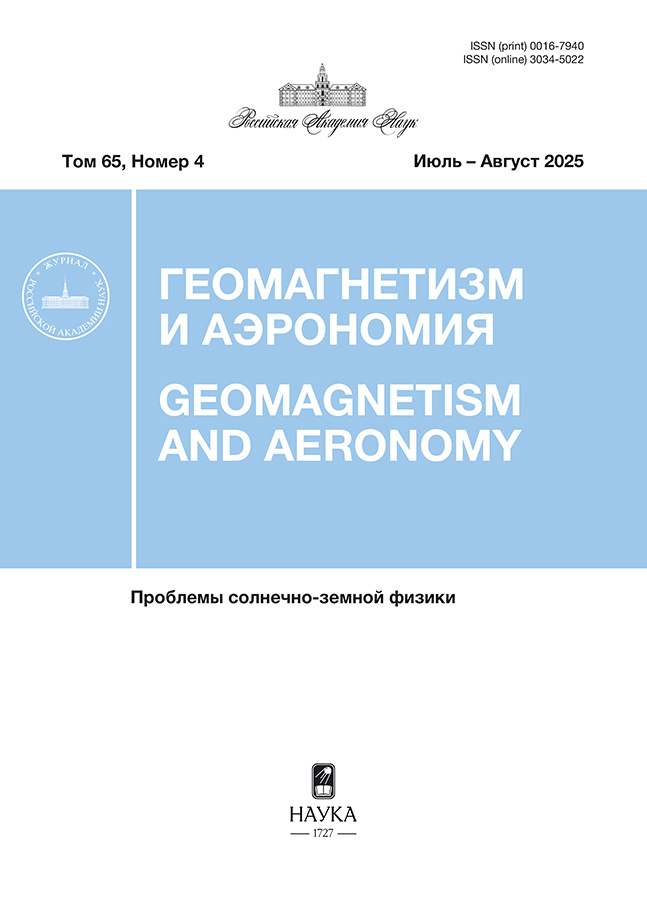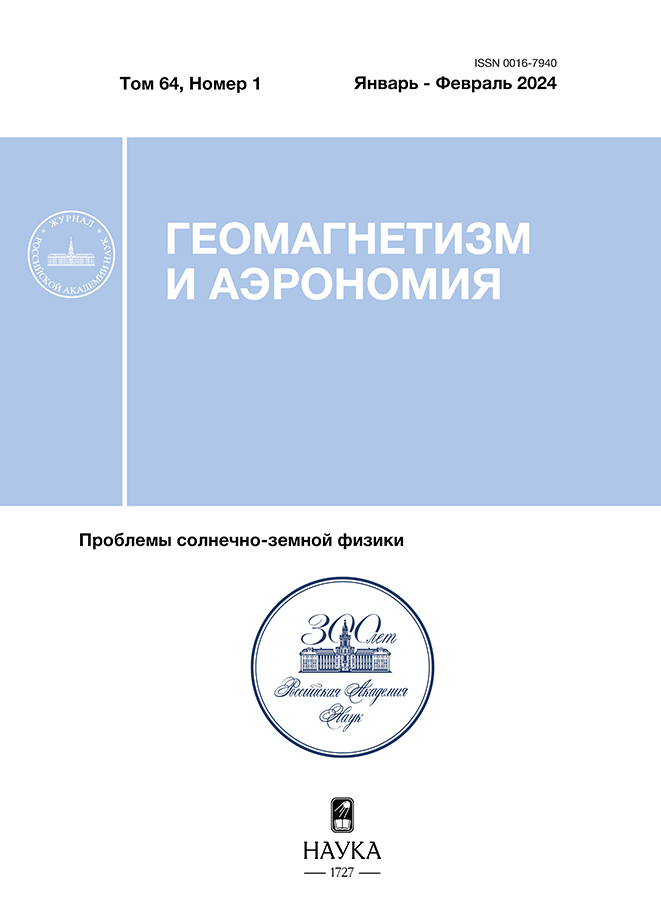Dependence of annual asymmetry in NmF2 on local time
- Authors: Shubin V.N.1, Badin V.I.1, Deminov M.G.1, Deminov R.G.2
-
Affiliations:
- Pushkov Institute of Terrestrial Magnetism, Ionosphere and Radio Wave Propagation, Russian Academy of Sciences (IZMIRAN)
- Kazan Federal University
- Issue: Vol 64, No 1 (2024)
- Pages: 93-100
- Section: Articles
- URL: https://ruspoj.com/0016-7940/article/view/650959
- DOI: https://doi.org/10.31857/S0016794024010091
- EDN: https://elibrary.ru/GQKLQT
- ID: 650959
Cite item
Abstract
Based on the global empirical model of the F2 layer critical frequency median (Satellite and Digisonde Data Model of the F2 layer, SDMF2), an analysis was made of the properties of diurnal variations in the annual asymmetry in the concentration of the F2 layer maximum NmF2 at different values of the solar activity index F. The AI index, which characterizes the relative difference in NmF2 averaged over all longitudes and latitudes between January and July at a given local time, was used as a parameter of this asymmetry. It was found that the diurnal variations of the AI index are dominated by a semidiurnal mode with maxima in the daytime and at night. The daytime maximum of the AI index is almost independent of the level of solar activity. The nighttime AI maximum decreases with increasing solar activity. For low solar activity, the daytime and nighttime AI maxima almost coincide in amplitude when AI = 16—17%. The difference in the solar radio flux between January and July due to the ellipticity of the Earth’s orbit relative to the Sun makes a significant contribution to the AI index at all hours of the day. On average, it is 3—4% and can reach 5% with low solar activity at night. The difference in the AI index for low and high activity according to the IRI model (with URSI and, especially, CCIR coefficients) is overestimated relative to the SDMF2 model at almost all hours of the day, apparently due to the limited number of experimental data when obtaining the CCIR and URSI coefficients especially over the oceans
Full Text
About the authors
V. N. Shubin
Pushkov Institute of Terrestrial Magnetism, Ionosphere and Radio Wave Propagation, Russian Academy of Sciences (IZMIRAN)
Author for correspondence.
Email: shubin@izmiran.ru
Russian Federation, Moscow
V. I. Badin
Pushkov Institute of Terrestrial Magnetism, Ionosphere and Radio Wave Propagation, Russian Academy of Sciences (IZMIRAN)
Email: shubin@izmiran.ru
Russian Federation, Moscow
M. G. Deminov
Pushkov Institute of Terrestrial Magnetism, Ionosphere and Radio Wave Propagation, Russian Academy of Sciences (IZMIRAN)
Email: shubin@izmiran.ru
Russian Federation, Moscow
R. G. Deminov
Kazan Federal University
Email: shubin@izmiran.ru
Russian Federation, Kazan
References
- Деминов М.Г., Шубин В.Н., Деминов Р.Г. Зависимость годовой асимметрии в NmF2 от геомагнитной широты и солнечной активности // Геомагнетизм и аэрономия. Т. 61. № 3. С. 347—353. 2021. https://doi.org/10.31857/S0016794021030032
- Деминов М.Г., Деминова Г.Ф. Зависимость локального индекса годовой асимметрии для NmF2 от местного времени и солнечной активности // Геомагнетизм и аэрономия. Т. 63. № 2. С. 147—153. 2023. https://doi.org/10.31857/S0016794022600636
- Шубин В.Н. Глобальная эмпирическая модель критической частоты F2-слоя ионосферы для спокойных геомагнитных условий // Геомагнетизм и аэрономия. Т. 57. № 4. С. 450—462. 2017. https://doi.org/10.7868/S0016794017040186
- Bilitza D. IRI the international standard for the ionosphere // Adv. Radio Sci. V. 16. P. 1—11. 2018. https://doi.org/10.5194/ars-16-1-2018
- Brown S., Bilitza D., Yigit E. Improvements to predictions of the ionospheric annual anomaly by the international reference ionosphere model // Ann. Geophys. Discuss. 2018. https://doi.org//10.5194/angeo-2018-97
- Dang T., Wang W., Burns A., Dou X., Wan W., Lei J. Simulations of the ionospheric annual asymmetry: Sun-Earth distance effect // J. Geophys. Res. —Space. V. 122. № 6. P. 6727—6736. 2017. https://doi.org/10.1002/2017JA024188
- Gulyaeva T.L., Arikan F., Hernandez-Pajares M., Veselovsky I.S. North-south components of the annual asymmetry in the ionosphere // Radio Sci. V. 49. № 7. P. 485—496. 2014. https://doi.org/10.1002/2014RS005401
- Gustafsson G., Papitashvili N.E., Papitashvili V.O. A revised corrected geomagnetic coordinate system for Epochs 1985 and 1990 // J. Atmos. Terr. Phys. V. 54. № 11—12. P. 1609—1631. 1992. https://doi.org/10.1016/0021-9169(92)90167-J
- Jones W.B., Gallet R.M. The representation of diurnal and geographic variations of ionospheric data by numerical methods // Telecommun. J. V. 29. № 5. P. 129—149. 1962.
- Jones W.B., Gallet R.M. Representation of diurnal and geographic variations of ionospheric data by numerical methods // Telecommun. J. V. 32. № 1. P. 18—28. 1965.
- Lei J., Dou X., Burns A., Wang W., Luan X., Zeng Z., Xu J. Annual asymmetry in thermospheric density: Observations and simulations // J. Geophys. Res. —Space. V. 118. № 5. P. 2503—2510. 2013. 10.1002/jgra.50253' target='_blank'>https://doi.org/doi: 10.1002/jgra.50253
- Mendillo M., Huang C.L., Pi X., Rishbeth H., Meier R. The global ionospheric asymmetry in total electron content // J. Atmos. Sol.-Terr. Phys. V. 67. № 15. P. 1377—1387. 2005. https://doi.org/10.1016/j.jastp.2005.06.021
- Mikhailov A.V., Perrone L. The annual asymmetry in the F2 layer during deep solar minimum (2008—2009): December anomaly // J. Geophys. Res. —Space. V. 120. № 2. P. 1341—1354. 2015. https://doi.org/10.1002/2014JA020929
- Rishbeth H., Müller-Wodarg I.C.F. Why is there more ionosphere in January than in July? The annual asymmetry in the F2-layer // Ann. Geophys. V. 24. № 12. P. 3293—3311. 2006. https://doi.org/10.5194/angeo-24-3293-2006
- Rush C.M., PoKempner M., Anderson D.N., Perry J., Stewart F.G., Reasoner R. Maps of foF2 derived from observations and theoretical data // Radio Sci. V. 19. № 4. P. 1083—1097. 1984. https://doi.org/10.1029/RS019i004p01083
- Rush C., Fox M., Bilitza D., Davies K., McNamara L., Stewart F., PoKempner M. Ionospheric mapping —an update of foF2 coefficients // Telecomm. J. V. 56. № 3. P. 179—182. 1989.
- Sai Gowtam V., Tulasi Ram S. Ionospheric annual anomaly —New insights to the physical mechanisms // J. Geophys. Res. —Space. V. 122. № 8. P. 8816—8830. 2017a. https://doi.org/10.1002/2017JA024170
- Sai Gowtam V., Tulasi Ram S. Ionospheric winter anomaly and annual anomaly observed from Formosat-3/COSMIC Radio Occultation observations during the ascending phase of solar cycle 24 // Adv. Space Res. V. 60. № 8. P. 1585—1593. 2017b. https://doi.org/10.1016/j.asr.2017.03.017
- Yonezawa T. The solar-activity and latitudinal characteristics of the seasonal, non-seasonal and semi-annual variations in the peak electron densities of the F2-layer at noon and at midnight in middle and low latitudes // J. Atmos. Terr. Phys. V. 33. № 6. P. 889—907. 1971. https://doi.org/10.1016/0021-9169(71)90089-4
- Zhao B., Wan W., Liu L., Mao T., Ren Z., Wang M., Christensen A.B. Features of annual and semiannual variations derived from the global ionospheric maps of total electron content // Ann. Geophys. V. 25. № 12. P. 2513—2527. 2007. https://doi.org/10.5194/angeo-25-2513-2007
- Zeng Z., Burns A., Wang W., Lei J., Solomon S., Syndergaard S., Qian L., Kuo Y.-H. Ionospheric annual asymmetry observed by the COSMIC radio occultation measurements and simulated by the TIEGCM // J. Geophys. Res. —Space. V. 113. № 7. A07305. 2008. https://doi.org/10.1029/2007JA012897
Supplementary files















